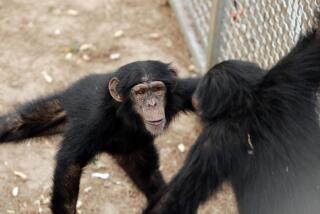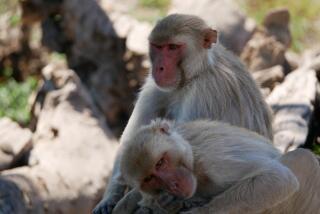Humans may look for the helpers, but bonobos prefer the troublemakers

Because bonobos appear to be more prosocial, scientists have long wondered if they may share such characteristics with humans, a highly cooperative species. A new study described in the journal Current Biology, found that these docile apes prefer i
- Share via
When Mr. Rogers told viewers of his beloved children’s TV show to “look for the helpers,” bonobos clearly weren’t paying attention. A new study of one of our closest living relatives finds that these docile apes prefer individuals who hinder over those who help.
The findings, described in the journal Current Biology, could shed light on the origins of “prosocial” behavior in human beings.
“A preference for helpers over hinderers,” the study authors wrote, may have “played a central role in the evolution of human development and cooperation.”
Bonobos, together with chimpanzees, are two of humans’ closest living relatives — and while they look fairly similar, there are many significant differences in their behaviors and social structure. Chimps have a tendency to engage in violent conflict; bonobos do not. Chimp social groups are male dominated, whereas bonobo groups are female dominated.
Because bonobos appear to be more prosocial — that is, they act in ways that foster social bonds and benefit the larger social group – scientists have long wondered if they may share such characteristics with humans, a highly cooperative species.
“As the most socially tolerant nonhuman ape, bonobos (Pan paniscus) provide a powerful phylogenetic test of whether this trait is derived in humans,” the study authors wrote. “Bonobos are more tolerant than chimpanzees, can flexibly obtain food through cooperation, and voluntarily share food in captivity and the wild, even with strangers. Their neural architecture exhibits a suite of characteristics associated with greater sensitivity to others.”
So do bonobos value cooperative, prosocial behaviors in the way humans do? In humans, that preference starts young: babies as young as 3 months old have been shown to favor people who they witness helping others.
To find out, researchers from Duke University set up a series of four experiments to test semi-free-ranging bonobos at the Lola ya Bonobo sanctuary in the Democratic Republic of Congo.
Half of the experiments involved animations of two-dimensional, cartoon-eyed shapes that helped or hindered each other. For example, in the first experiment bonobos watched videos of a circle (with eyes) trying to climb a steep hill, and failing. In one version, a triangle with eyes helped push the struggling circle up the hill. In another, a square with eyes shoved the circle back down. (The researchers also showed control versions of these films, in which a plain, eyeless circle was pushed up or down a hill.)
A bonobo was then offered a choice between two slices of apple, each with a different paper shape on it. To their surprise, the researchers found that only two bonobos chose the helper shape on a majority of the trials; 11 of them chose the hinderer.
“This finding suggests that bonobos can discriminate between prosocial and antisocial agents but that they do not show the human preference for prosocial agents,” the study authors wrote.
The next two experiments involved live-action entertainment. Three humans acted out a little scene: One played with a toy and then dropped it; a second person picked it up and returned it, and a third person snatched the toy away. The helping and hindering humans then stepped forward, each presenting a fruit slice to the observing bonobo. Again, the bonobos largely preferred the offering from the hinderer, and not the helper.
If bonobos are so tolerant and social, why do they seem to prefer antisocial individuals, whether animated or human? It may be that antisocial behavior is associated with dominance — and dominance still plays a role in these apes’ lives.
To test that, the researchers ran another animated experiment. This time, the videos presented two different scenarios. In the first, a cartoon-eyed trapezoid tried to enter a circle on the ground, and a cartoon-eyed pentagon repeatedly shoved it out, claiming the circle as its own. In the second, a square and triangle (both with eyes) took turns hanging out in the circle. Again, when presented with shape-covered fruit slices, the bonobos tended to go for the pushy pentagon.
Theoretically, being a hindrance and being dominant are not inextricably linked; one could potentially be helpful and dominant, or antisocial and submissive. But differentiating between apes’ reactions those two distinct qualities will need to be sorted out in future work, the researchers said.
This preference was only significant in the adult bonobos, and not the younger ones — to a certain point, given that none of the bonobos tested were under four years old. Because of that, the researchers couldn’t fully determine whether this antisocial/dominant preference existed in bonobo infants, or whether it developed later.
Regardless, the findings could indicate that such a prosocial preference might be a particularly human trait, the study authors said.
“Our results support the predictions of the dominance hypothesis and raise the possibility that the motivation to prefer prosocial individuals evolved in humans after their divergence from the other apes,” the scientists wrote.
The next step is to study these behaviors in other species of apes, including chimpanzees, the researchers said.
Follow @aminawrite on Twitter for more science news and “like” Los Angeles Times Science & Health on Facebook.
MORE IN SCIENCE
11 science stories we’re looking forward to in 2018
Do psychiatrists have any business talking about President Trump’s mental health?
Autism spectrum disorders appear to have stabilized among U.S. kids and teens






